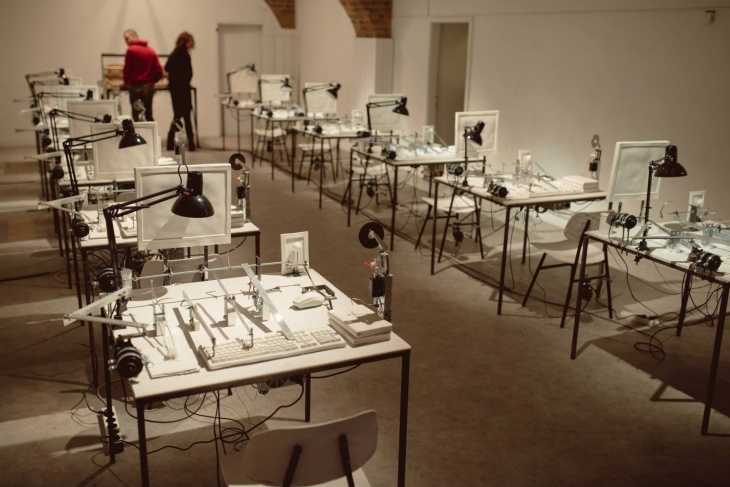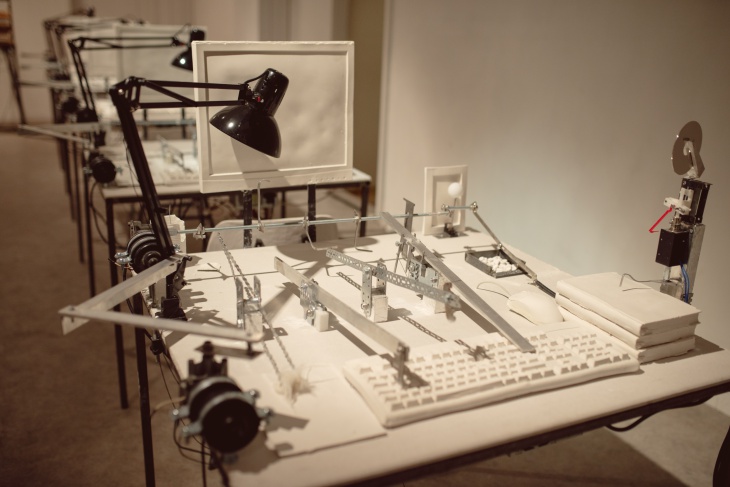Lenka Đorojević & Matej Stupica: Neur-O-Matic
Analogue interactive installation
 Neur-O-Matic is a series of twelve identical situations displaying the average generic workplace of the cognitive precariat, whose labour is deeply rooted in the absurdly static environment of communication capitalism. Unconscious gestures, dictated by information technology are triggering ideological operations in space-time medium, in which time is increasingly limited and space progressively diffused.
The authors (in close collaboration with electrical engineers Simon Bergoč and Boris Košak and sculptors Neža Jurman and Staš Vrenko) have chafed this fantasia of the abundance of knowledge and information to its essence – to the absurd, whose desire due to its inability to achieve gratification is bent upon destruction. The installation mechanism is set on partly self-destructing the installation, manifesting the fragmented and disruptive results of the overproduction. All twelve situations are linked into a central network, that triggers the hammers punching on these clones. The central operating system of the installation works as an online environment connecting all twelve units together. Visitors are likened to the roles of operators, who are unable to control their actions, for every keystroke denotes destruction.
The only means of resistance and transformation of the inert overproduction and operation is a radical withdrawal from the system and absolute inaction.
Neur-O-Matic is a series of twelve identical situations displaying the average generic workplace of the cognitive precariat, whose labour is deeply rooted in the absurdly static environment of communication capitalism. Unconscious gestures, dictated by information technology are triggering ideological operations in space-time medium, in which time is increasingly limited and space progressively diffused.
The authors (in close collaboration with electrical engineers Simon Bergoč and Boris Košak and sculptors Neža Jurman and Staš Vrenko) have chafed this fantasia of the abundance of knowledge and information to its essence – to the absurd, whose desire due to its inability to achieve gratification is bent upon destruction. The installation mechanism is set on partly self-destructing the installation, manifesting the fragmented and disruptive results of the overproduction. All twelve situations are linked into a central network, that triggers the hammers punching on these clones. The central operating system of the installation works as an online environment connecting all twelve units together. Visitors are likened to the roles of operators, who are unable to control their actions, for every keystroke denotes destruction.
The only means of resistance and transformation of the inert overproduction and operation is a radical withdrawal from the system and absolute inaction.
Vsebina
Past Events
- Solo Exhibition at U10, Kralja Milana 10, Belgrade, Serbia | September 7th – October 13th 2017
- Beyond the Globe | 8th Triennial of Contemporary Art – U3, Modern Gallery, Ljubljana | 3 June 2016 — 18 September 2016
- Solo Exhibition at MoTA Point, Gosposvetska 12, Ljubljana | December 19th 2014 – January 16th 2015
Catalogue
About the authors
Matej Stupica is a new media artist of the younger generation, working primarily in the field of visual art and multimedia installations. In 2014 he graduated in painting at the Faculty of Arts in Ljubljana with the work Escape from Alcatraz. During a 3-month student exchange program in the academic year 2010/2011 he attended classes in Jiří Černický's painting studio at the Academy of Arts, Architecture and Design in Prague. With solo and group projects, interventions and exhibitions he participates in Slovenia and abroad. As of 2006 he is an illustrator for the newspaper Dnevnik's Saturday supplement, Objektiv. His illustrations were exhibited at the 8th and the 11th Slovenian Biennial of Illustration, where he received the Hinko Smrekar Recognition and a special commendation of the jury for his newspaper illustration. He received the Academy of Fine Arts in Ljubljana Award in 2009 for outstanding artistic achievements for his work in the field of visual arts, and the Student's Prešeren Award for painting in 2011. With his last projects he was, inter alia, a part of the 7th Triennial of Contemporary Art U3. He lives and works in Ljubljana.
Lenka Đorojević stems from the field of graphic arts, which can be seen in her work directly, or through the inclusion of this medium's processes in her new media installations and theatre sets. In 2009 she graduated from the Academy of Fine Arts in Trebinje in Bosnia and Herzegovina and went on to study additionally at the International Summer Academy in Salzburg. She received her Master's degree at the Academy of Fine Arts in Ljubljana in 2013 on the subject of the Graphics of regeneration; her work was a spatial graphic installation named Cube 837456-9305.00, exhibited at the Centre of Contemporary Arts - Art Salon Celje and Alkatraz Gallery in Ljubljana. She has also completed a two-year school for curators and critics of contemporary art Arts Council, which was organized by the Institute for Contemporary Arts SCCA Ljubljana. She is a contributing author for the Culture and Humanities Editorial board at Radio Študent Ljubljana and a co-founder of the Society for Sound and Visual Art OFFTIR, which was presented at the 7th Triennial of Contemporary Art U3 in Slovenia. She currently lives and works in Ljubljana.
The only non-violent action is inaction
Neur-o-matic is a space expressing the antagonisms produced by technologically enriched human beings. The new era of cultural history isn't marked with the antonyms between social stigmatization and individual autonomy. One should no longer analyse culture, identity and technology through the perspective of opposites between binary duals, such as public and private, object and subject, human and machine, for the use of technology and the multilateral, multi-directional, constant entanglement between the man and the machine doesn't permit thoughts about opposing social forces, such as individual freedom in opposite to automated alienation. Contemporary individuals are prone to the intimate use of technology. They appropriate the structural characteristics of automated procedures and change them into multi-layered interfaces for the expression of their own autonomy or self-determination. By the said use of technology the procedure of subjectivization is expressed and the role of the body and the machine radically changes in living and working relations. Indeterminate, improvised and confused aggregation of seemingly separate categories that through neural network manage to find themselves in the same context, in nearly at the same place (just one click away from anything else), at virtually the same time (depending on social-economic class, geopolitical location conditioning data bandwidth) leads to a the formation of a uniform place where contents can be found (an on-line interface, a shopping mall, a classroom), contents which have totally dissimilar genealogies or tendencies, be it political or scientific. The uniformity of the interfaces that connect indistinctly between diverse field lines is precisely why I would like to express doubt in the emancipatory potential of this aggregation, for deeds and things are not what they seem. The concept of Neur-o-matic, based on the repetition of an uniform working environment or the interface for the production of precarious cognitatiat, is based on an idea of such uniformity that expresses in working relations regardless of the »diversity« of modern immaterial labour marked by short impulses of attention, constant distractions and interference, in short with multitasking. Perhaps it is precisely this apparent multiplicity where I can find the most ubiquitous antagonism of the present time, which is strongly expressed in all parts of the globalized world, irrespective of cultural background. I don't allude to universality, but the despotism of capitalism, whose operation is imposed regardless of the different political options, in which it is packaged. In the words of Baudrillard, any thing or decision is a part of business or consumer marketing, even though everything look as though it is political. In this context, policy has become entertainment and business at the same time, while science and art have become commodified and popularized.
Perhaps it is no coincidence that in the context of demand and sales I can only read about art multiples on-line as inexpensive and affordable, therefore comodified artistic outputs that adapt its symbolical (capital) value and the material (formal) features of the art works to the needs of the market. Although I recognize this kind of production as a legitimate part of the survival tactics of artists and artistic groups and do not in the least want to romanticize some kind of symbolic value of artwork, which, to be honest, has never been without connection to the capital, it seems to me that the artistic methods of multiplication should be far from narrowed down to just cute, portable and accessible consumer products. The effect and purpose of multiples is from installation to installation, of course, different. With the Swiss artist Zimoun it is about seeking sound effects that uses mechanical means to imitate nature and visual effects that imitate the organic flickering and physical waves. Neur-o-matic also is directed towards finding a sound effect. Instead of computer keyboard tapping, so typical a noise in working units or factories of the cognitatiat, what rings is the unpredictable mechanistic violence produced by the saturation with information and the constant and ever increasing production. In the words of Bojana Kunst, this is »radical consumption, not in the sense of money, but in the sense of energy and human possibilities and actions [which] is in the heart of the spirit of modern capitalism, where the Protestant asceticism has been replaced by the imperative of (ascetic) pleasure«*. This »radical consumption« is also where the fundamental absurdity of the Neur-o-matic installation lies – by threshing on the plaster casts of computer and office machines it causes a progressive and at least partial self-destruction. When the exhibition ends there will be little of the installation left. You will not be able to buy the multiples. Neur-o-matic takes into account the conceptual history of multiples which sprang up in the 60's as a means for linguistic deconstruction eliminating the difference between the marked and the marker. The table is shown as the most »table-ly« table, or that, which is not capable of subjectivation.
The heart of the absurd lies not solely in this extreme uselessness or self-damage of the system. It can also be found in the role and operation of the neural network, which oversees the space like a supervisor in the middle, from a chairing position. It introduces a longitudinal perspective onto the network connection in the space. It seem the formation does not comply with the idea of the risomatic integration so typical for, let's say, on-line environments. However, as described earlier, this multi-directional linking has mostly just to do with the apparently open forms still following totally dogmatic (uniform) knowledge. The central and chairing position controls and determinates knowledge of a certain working unit just as an ideologue in schools – as a main centre of power and control. Visitors, who are generally acquainted with the choreography of interactive installations will know that they can use the neural centre to manage the response of the individual tables. Yet there is a sinister intention to this fun and games for we never know what a certain action will produce – a pleasant hum of the engine, or total chaos. There is a devastating potential ingrained into the keys, the devastating potential of the intangible production of information, not in the moralistic sense, but from a desire to aggravate the idea of the complete reduction of the excessive production and radical consumption.
The enthusiasm for the absurdist literature of Daniil Harms, almost a century year old writings, which have triggered the first reflections about the installation and found their place in the hacked telephone room that was exhibited as a separate part of the installation's layout is not a desire to revive the absurdist movement, but a tendency towards the establishment of the antagonisms in the individual's relation to work and political participation or post-political interpasivity. The layout of the gallery space is reminiscent of a classroom or the work environment in cubicles. Wikipedia tells me that when first working cubicles and open offices where office workers were all lined up appeared, they were called action offices. As with livestock farming the concept of these cubicles is to rationalize space and not to create an open or uncontrolled situation. The cubicles are supposed to enable maximum concentration at minimum quadrature, at the same time allowing for a panoptic view from above without the worker knowing when s/he is being watched. The work situation is, despite numerous possibilities, reduced to elements/interfaces that are the same everywhere.
The system named Neur-o-matic tests the mood of contemporary cognitariat in its working environment, which precisely due to the apparency of transformations, the impossibility of autonomy and the inability of self-determination feels even more uncomfortable, trapped, limited, tense and regulated, just as though this inability is transparently expressed. Neur-o-matic is a system for the initiation of radical responsibility when operating, since every action is violent and the only possible rebellion against violence is inaction or action without control (wúwéi).
Text by Ida Hiršenfelder.
Credits
Concept and realization: Lenka Đorojević & Matej Stupica
Multiplication and moulding: Neža Jurman
Multiplication and motorization: Boris Košak
Multiplication: Blaž Božič
Wiring: Simon Bergoč & Tina Dolinšek
Electro-advice: Brane Ždralo
Telephony: Luka Frelih
Telephony and audio book editing: Staš Vrenko
Audio book mix: Jure Gruden
Video: Guillermo Algora
Lights: Martin Lovšin Schintr
Wording and editing: Ida Hiršenfelder
Wording and translations: Bojan Stefanović
Proofreading: Miha Kelemina
Public Relations: Polona Torkar
Harms audio book voices: Nejc Bahor, Blaž Božič, Primož Čučnik, Jasmin B. Ferlih, Karlo Hmeljak, Željko Hrs, Dejan Koban, Marko Mlačnik, Tjaša Koprivec, Mira Lampe Vujičić, Ivan Lotrič, Dušan Merklin Mick, Ana Pepelnik, Tone Škrjanec, Polona Torkar in Andreja Štepec
DIY workshop participants: Urša Dolinšek, Polona Torkar, Nina Sever, Sara Šabjan, Julijan Strajnar & Tilen Nedanovski
Producers: Uroš Veber & Tina Dolinšek
Special credits
Katerina Mirović (Strip Core), Martin Lovšin Schintr (Glej Theatre), Public company Snaga, Jure Sajovic, Mira K. Veljić and Stane Dežman (NAMA), Dario Sereval, Vito Pšeničny and Miha Bučar (City Municiaplity Ljubljana), Alenka Miklavžin (Ministry of Agriculture, Forestry and Food), Blaž Peršin and Martin Horvat (City Museum of Ljubljana), Mojca Jan Zoran and Dušan Nelec (Slovenian Theatre Institute), Marko Peljhan, ...
Production: Projekt Atol Institute (Uroš Veber) and Društvo Ljudmila, Art and Science Laboratory (Tina Dolinšek)
Co-production: MOTA – Museum of Transitory Art
Project was supported by Ministry of Culture and City Municipality of Ljubljana – Department for Culture.

